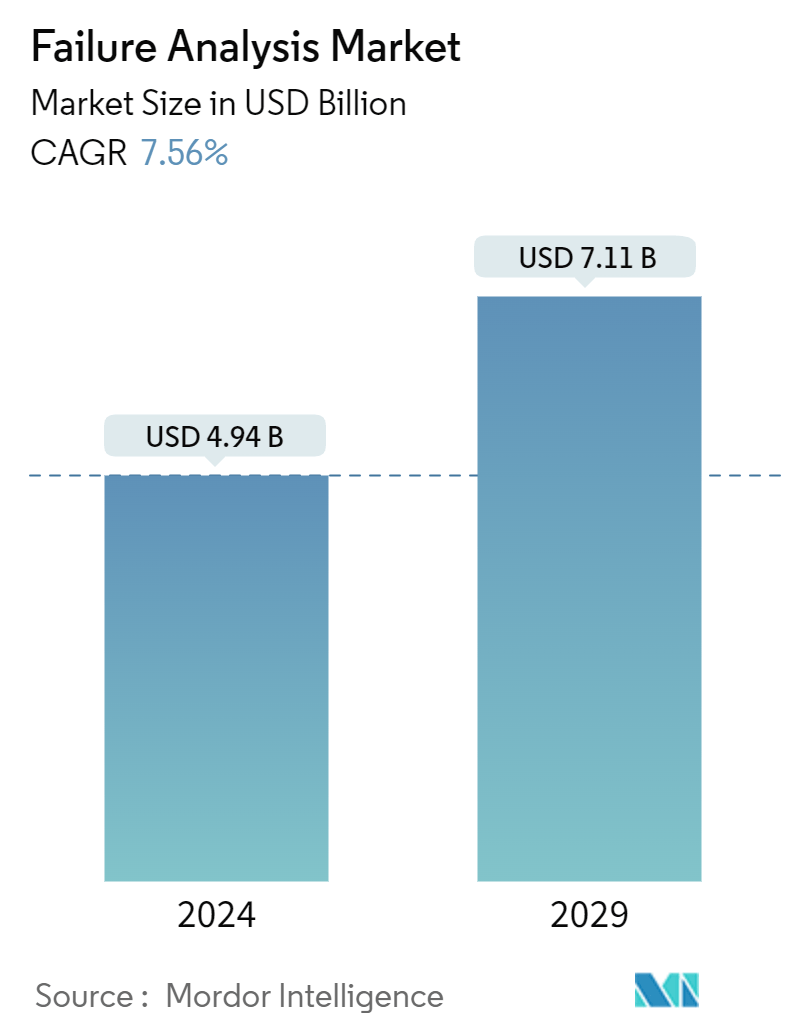Market Size of Failure Analysis Industry

| Study Period | 2019 - 2029 |
| Market Size (2024) | USD 4.94 Billion |
| Market Size (2029) | USD 7.11 Billion |
| CAGR (2024 - 2029) | 7.56 % |
| Fastest Growing Market | Asia Pacific |
| Largest Market | Asia Pacific |
| Market Concentration | Low |
Major Players
*Disclaimer: Major Players sorted in no particular order |
Failure Analysis Market Analysis
The Failure Analysis Market size is estimated at USD 4.94 billion in 2024, and is expected to reach USD 7.11 billion by 2029, growing at a CAGR of 7.56% during the forecast period (2024-2029).
Failure analysis is the process of gathering and analyzing data to determine the cause of failure and determine corrective actions or liability. It is crucial to understand the root cause of failure to prevent similar incidents in the future. Some of the common causes include assembly error, misuse or abuse, fastener failure, inadequate maintenance, manufacturing defects, low-quality material, improper heat treatments, unforeseen operating conditions, design errors, insufficient quality assurance, inadequate environmental protection, and casting discontinuities.
• Root Cause Analysis (RCA) is crucial for continuous quality improvement across industries. It begins by examining incidents, defects, and quality issues to identify their root causes. This process helps organizations address factors compromising product or service quality, preventing future recurrences. RCA also reveals process inefficiencies, enhancing both quality and operational efficiency. As RCA expands the scope of failure analysis, its growth is expected to create new opportunities in the failure analysis market.
• Aged infrastructure poses a threat to the system, as unstable infrastructure raises the chances of breakdowns during severe and prolonged strain, which is particularly worrisome during extreme circumstances. Infrastructure resiliency has recently come into focus, especially as the number and severity of natural disasters are increasing, causing significant economic impacts and loss of life.
• In addition to this, the increasing requirement for failure analysis among automobile manufacturers, who are also employing vision and AI-based analysis tools for performance analysis, dynamic vehicle studies, accident reconstruction, etc., is augmenting the market. Besides this, the inflating investments in the advancement of the nanotechnology sector are anticipated to fuel the failure analysis market over the forecasted period.
• The cost of failure analysis equipment, including transmission electron microscopes (TEM), scanning electron microscopes (SEM), and focused ion beam systems, is considerably high. In contrast, optical microscopes are less expensive than electron microscopes despite the fact that the latter provides more advanced capabilities and a wider range of applications.
• In 2023, the semiconductor industry's global significance continues to escalate. Semiconductor chips are not only integral to the essential technologies of today but are also paving the way for the transformative innovations of tomorrow.
• However, alongside its promising future, the industry faces a myriad of challenges. Persistent US-China tensions are reshaping the global supply chain, leading to heightened government restrictions on chip sales to China, which remains the world's largest semiconductor market. Addressing these challenges, policymakers are urged to implement strategies that bolster US leadership in semiconductor design, enhance the domestic workforce through comprehensive immigration and STEM education reforms, and advocate for free trade and market access to sustain the industry's growth trajectory.
Failure Analysis Industry Segmentation
Failure analysis is an investigation of failure, which generally aims at identifying the cause and taking appropriate measures to correct it or mitigate its consequences. For the prevention of future asset and product failures, as well as to mitigate potential dangerous hazards for humans and the environment, failure analysis is carried out at all parts of the industrial sector, such as oil and gas, aerospace and defense, engineering and fabrication, power, marine, rail, automotive, electronics and sensors, medical equipment, etc.
The failure analysis market is segmented by technology (secondary ion mass spectrometry (SIMS), energy dispersive X-ray spectroscopy (EDX), chemical mechanical planarization (CMP), scanning probe microscopy, focused ion beam (FIB), relative ion etching (RIE) and other technology types), equipment (scanning electron microscope (SEM), focused ion beam (FIB) system, transmission electron microscope (TEM), and dual beam system, other equipment), end-user vertical (automotive, oil and gas, defense, construction, manufacturing, electronics and semiconductors and other end-user verticals), and geography (North America, Europe, Asia-Pacific, Latin America and Middle East and Africa). The market sizes and forecasts are provided in terms of value (USD) for all the above segments.
| By Technology | |
| Secondary ION Mass Spectrometry (SIMS) | |
| Energy Dispersive X-ray Spectroscopy (EDX) | |
| Chemical Mechanical Planarization (CMP) | |
| Scanning Probe Microscopy | |
| Focused Ion Beam (FIB) | |
| Relative Ion Etching (RIE) | |
| Other Technologies |
| By Equipment | |
| Scanning Electron Microscope (SEM) | |
| Focused Ion Beam (FIB) System | |
| Transmission Electron Microscope (TEM) | |
| Dual Beam System | |
| Other Equipment |
| By End-user Vertical | |
| Automotive | |
| Oil and Gas | |
| Defense | |
| Construction | |
| Manufacturing | |
| Electronics and Semiconductors | |
| Other End-user Verticals |
| By Geography*** | |
| North America | |
| Europe | |
| Asia | |
| Australia and New Zealand | |
| Latin America | |
| Middle East and Africa |
Failure Analysis Market Size Summary
The failure analysis market is poised for significant growth, driven by the increasing complexity of products and the need for quality assurance across various industries. This market encompasses the process of identifying and analyzing the root causes of failures to prevent future occurrences, thereby enhancing product reliability and operational efficiency. The demand for failure analysis is particularly strong in the electronics and semiconductor sectors, where it plays a crucial role in maintaining quality standards and improving manufacturing processes. The market is also experiencing growth due to the rising need for infrastructure resiliency, especially in regions prone to natural disasters. As urbanization and industrialization continue to rise, particularly in the Asia-Pacific region, the importance of failure analysis in infrastructure development becomes even more pronounced.
The market landscape is characterized by a high level of competition, with numerous companies offering failure analysis services across different sectors. Key players are actively expanding their operations through strategic collaborations and acquisitions to enhance their market presence and product capabilities. Technological advancements, such as the development of advanced microscopy tools, are further propelling the market forward. Despite the high costs associated with failure analysis equipment, the demand remains robust due to the critical need for quality assurance and defect prevention. The semiconductor industry's growth, coupled with the increasing investments in infrastructure and technology, is expected to drive the market's expansion over the forecast period.
Failure Analysis Market Size - Table of Contents
-
1. MARKET INSIGHTS
-
1.1 Market Overview
-
1.2 Industry Value Chain Analysis
-
1.3 Industry Attractiveness - Porter's Five Forces Analysis
-
1.3.1 Bargaining Power of Suppliers
-
1.3.2 Bargaining Power of Consumers
-
1.3.3 Threat of New Entrants
-
1.3.4 Threat of Substitute Products
-
1.3.5 Intensity of Competitive Rivalry
-
-
1.4 Impact of COVID-19 Aftereffects and Other Macroeconomic Factors on the Market
-
-
2. MARKET SEGMENTATION
-
2.1 By Technology
-
2.1.1 Secondary ION Mass Spectrometry (SIMS)
-
2.1.2 Energy Dispersive X-ray Spectroscopy (EDX)
-
2.1.3 Chemical Mechanical Planarization (CMP)
-
2.1.4 Scanning Probe Microscopy
-
2.1.5 Focused Ion Beam (FIB)
-
2.1.6 Relative Ion Etching (RIE)
-
2.1.7 Other Technologies
-
-
2.2 By Equipment
-
2.2.1 Scanning Electron Microscope (SEM)
-
2.2.2 Focused Ion Beam (FIB) System
-
2.2.3 Transmission Electron Microscope (TEM)
-
2.2.4 Dual Beam System
-
2.2.5 Other Equipment
-
-
2.3 By End-user Vertical
-
2.3.1 Automotive
-
2.3.2 Oil and Gas
-
2.3.3 Defense
-
2.3.4 Construction
-
2.3.5 Manufacturing
-
2.3.6 Electronics and Semiconductors
-
2.3.7 Other End-user Verticals
-
-
2.4 By Geography***
-
2.4.1 North America
-
2.4.2 Europe
-
2.4.3 Asia
-
2.4.4 Australia and New Zealand
-
2.4.5 Latin America
-
2.4.6 Middle East and Africa
-
-
Failure Analysis Market Size FAQs
How big is the Failure Analysis Market?
The Failure Analysis Market size is expected to reach USD 4.94 billion in 2024 and grow at a CAGR of 7.56% to reach USD 7.11 billion by 2029.
What is the current Failure Analysis Market size?
In 2024, the Failure Analysis Market size is expected to reach USD 4.94 billion.

